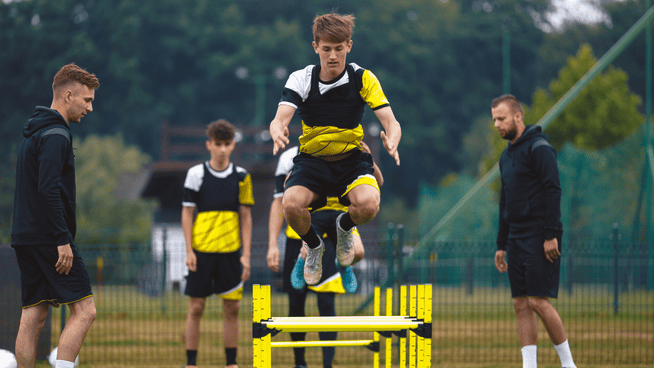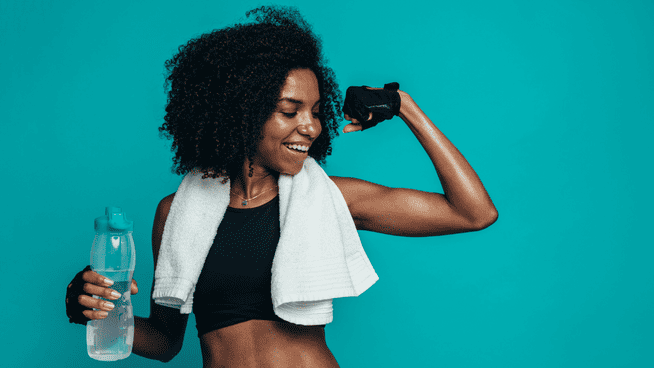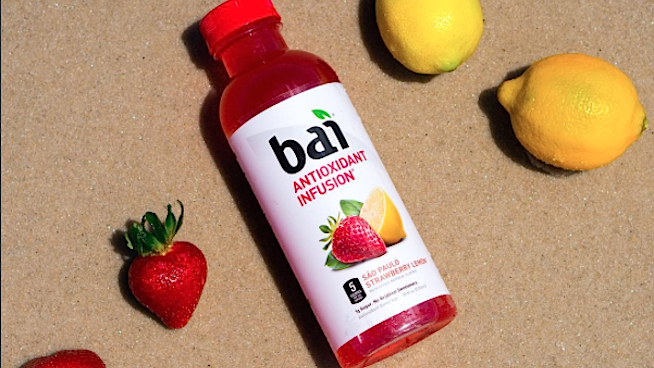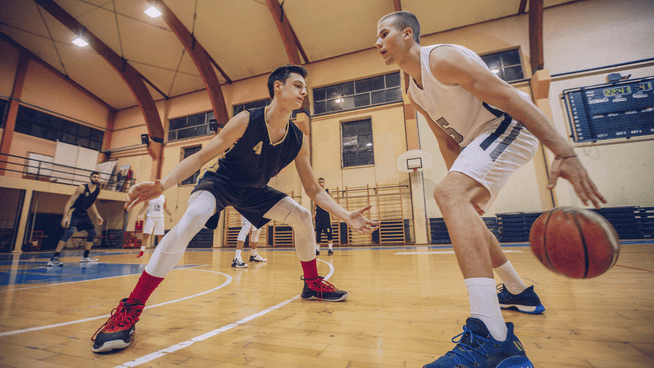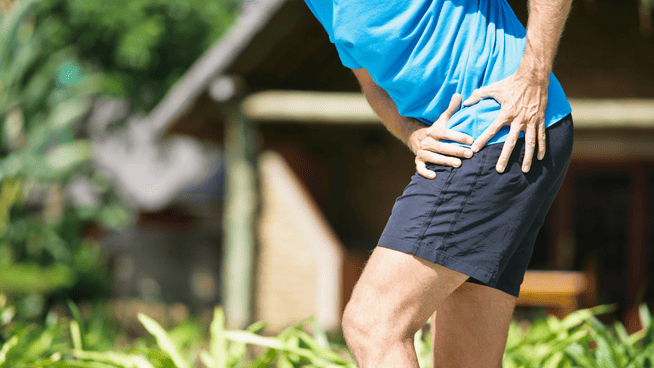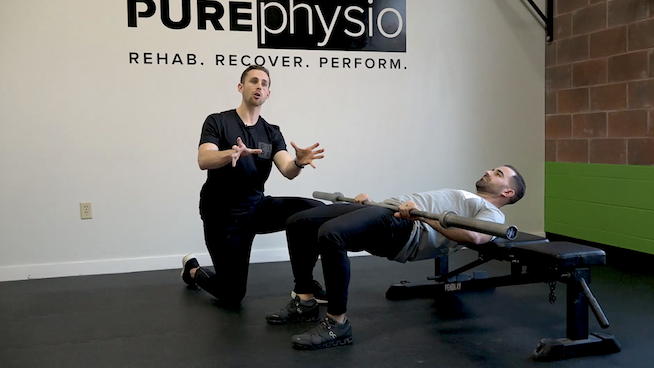6 Unilateral Exercises For Improved Athletic Performance
You’re strongest when lifting with two hands or both feet on the ground like a squat or a bench press. Here you’ll have better stability and the ability to lift more weight. And this is great for building strength and improving performance.
But without unilateral programming exercises and only doing bilateral lifts may lead to muscle imbalances, injuries, and decreased performance. When lifting or playing, you all have a dominant side, and one side may take over for the other. This leads to one side working harder than the other, resulting in muscle strains and missed tackles.
Better to program these six unilateral exercises for improved performance for on and off the field.
3 Performance Benefits Of Unilateral Exercises
Besides improving strength, here are three important benefits of performing unilateral exercises.
Reduced Muscle Imbalances And Injuries
Due to activities of daily living and bilateral lifting, most people have a dominant and non-dominant side. For example, kicking or throwing a ball. Lifting with one limb at a time helps the non-dominant side catch up. Strengthening your “weaker” side will reduce your injury risk by improving your technique. (1) (2)
Improved Balance
While lifting unilaterally, you automatically throw your body off-balance, forcing your core muscles to engage to keep yourself upright. Staying upright is handy because not many plays are made on your hands and knees.
Matches What Happens On The Field
Most sports and activities involve a lot of single leg action. Whether it is sprinting, throwing, jumping, or taking the stairs, it is rare for both feet to be on the ground at the same time during these movements.
6 Unilateral Exercises For Improved Performance
There are many great unilateral exercises, and it’s hard to narrow it down to six. But these six exercises are easy, accessible, and not technical. These can be performed in any weight room to improve the performance of your athletes.
Single Leg Hip Extension
Single leg hip extensions build strong and active glutes, important for pelvic alignment, lower back support, and stronger hamstrings. All of this will help you run faster and jump higher. The single-leg hip extension puts more of your body weight on one foot, not only to strengthen the glutes but to remove strength imbalances between sides.
Many athletic movements have hip extension as their base, and reducing strength imbalances will only help improve performance.
Elevated Split Squat
Single leg exercises like split squats are necessary for sports performance because running or changing direction requires single leg balance and strength. The increased range of motion of the elevated split squat (as opposed to other single-leg variations) emphasizes your quad and hip strength, which is a must-have for running faster. Yes, they’re challenging but think of this as bad-tasting medicine that helps improve your performance.
The increased ROM improves your hip mobility, which helps improve hip extension strength and reduces lower back pain.
Suitcase Carry
A Suitcase will strengthen your grip imbalances between hands, limiting factors when pulling heavy from the floor or tackling an opponent to the ground. Not only does the suitcase carry improve your grip, but they help to improve your conditioning and mental toughness.
Are they hard? Yes, but these have a huge carryover to sports and lifting performance and have substantial health benefits.
Single Arm Floor Press
The reduced range of motion of the floor press makes this a great triceps builder and will help you get stronger with the lockout part of any pressing exercise. The single-arm variation will turn on your core and shoulder stabilizers due to the offset load which helps improve core strength and balance. Throwing a ball, pushing your opponent off you, and keeping hold of the ball all involve unilateral elbow extension and pressing strength.
Single Arm Band Row
This move is so simple that it’s often overlooked because athletes usually head over to the dumbbells or barbells for their back work. But rowing with the band mimics the pulling motion when you’re pulling an opponent to the ground and the motion before throwing a ball. Plus, this exercise works the neglected muscles in between the shoulder blades that are important for shoulder health to help you stay on the field of play.
Single Arm Landmine Press
This exercise combines a vertical (shoulder press) and horizontal (push-up) movement, which makes this great for people who lack shoulder mobility for overhead pressing but still need strengthening in the overhead position—for example, volleyball, basketball, and tennis players. Adding the reach at the end of the exercise is great for the serratus anterior (boxer muscle underneath the chest), which is vital for shoulder health and mobility.
Conclusion
Strength is a significant factor in sports performance, and nothing builds it like the barbell squat, deadlift, and bench press. But because you have a dominant and non-dominant side, strength imbalances creep in that can cause niggles and decreased performance. Better to program unilateral exercises to help improve performance in the gym and the sporting field.
Your opponents will not know what hit them.
References
1. Lee JW, et al. Eccentric hamstring strength deficit and poor hamstring-to-quadriceps ratio are risk factors for hamstring strain injury in football: A prospective study of 146 professional players. J Sci Med Sport. 2018 Aug;21(8):789-793. Epub 2017 Dec 5.
2. Matthew N Bourne et al. An Evidence-Based Framework for Strengthening Exercises to Prevent Hamstring Injury. Sports Med. 2018 Feb;48(2):251-267. DOI: 10.1007/s40279-017-0796-x.
RECOMMENDED FOR YOU
6 Unilateral Exercises For Improved Athletic Performance
You’re strongest when lifting with two hands or both feet on the ground like a squat or a bench press. Here you’ll have better stability and the ability to lift more weight. And this is great for building strength and improving performance.
But without unilateral programming exercises and only doing bilateral lifts may lead to muscle imbalances, injuries, and decreased performance. When lifting or playing, you all have a dominant side, and one side may take over for the other. This leads to one side working harder than the other, resulting in muscle strains and missed tackles.
Better to program these six unilateral exercises for improved performance for on and off the field.
3 Performance Benefits Of Unilateral Exercises
Besides improving strength, here are three important benefits of performing unilateral exercises.
Reduced Muscle Imbalances And Injuries
Due to activities of daily living and bilateral lifting, most people have a dominant and non-dominant side. For example, kicking or throwing a ball. Lifting with one limb at a time helps the non-dominant side catch up. Strengthening your “weaker” side will reduce your injury risk by improving your technique. (1) (2)
Improved Balance
While lifting unilaterally, you automatically throw your body off-balance, forcing your core muscles to engage to keep yourself upright. Staying upright is handy because not many plays are made on your hands and knees.
Matches What Happens On The Field
Most sports and activities involve a lot of single leg action. Whether it is sprinting, throwing, jumping, or taking the stairs, it is rare for both feet to be on the ground at the same time during these movements.
6 Unilateral Exercises For Improved Performance
There are many great unilateral exercises, and it’s hard to narrow it down to six. But these six exercises are easy, accessible, and not technical. These can be performed in any weight room to improve the performance of your athletes.
Single Leg Hip Extension
Single leg hip extensions build strong and active glutes, important for pelvic alignment, lower back support, and stronger hamstrings. All of this will help you run faster and jump higher. The single-leg hip extension puts more of your body weight on one foot, not only to strengthen the glutes but to remove strength imbalances between sides.
Many athletic movements have hip extension as their base, and reducing strength imbalances will only help improve performance.
Elevated Split Squat
Single leg exercises like split squats are necessary for sports performance because running or changing direction requires single leg balance and strength. The increased range of motion of the elevated split squat (as opposed to other single-leg variations) emphasizes your quad and hip strength, which is a must-have for running faster. Yes, they’re challenging but think of this as bad-tasting medicine that helps improve your performance.
The increased ROM improves your hip mobility, which helps improve hip extension strength and reduces lower back pain.
Suitcase Carry
A Suitcase will strengthen your grip imbalances between hands, limiting factors when pulling heavy from the floor or tackling an opponent to the ground. Not only does the suitcase carry improve your grip, but they help to improve your conditioning and mental toughness.
Are they hard? Yes, but these have a huge carryover to sports and lifting performance and have substantial health benefits.
Single Arm Floor Press
The reduced range of motion of the floor press makes this a great triceps builder and will help you get stronger with the lockout part of any pressing exercise. The single-arm variation will turn on your core and shoulder stabilizers due to the offset load which helps improve core strength and balance. Throwing a ball, pushing your opponent off you, and keeping hold of the ball all involve unilateral elbow extension and pressing strength.
Single Arm Band Row
This move is so simple that it’s often overlooked because athletes usually head over to the dumbbells or barbells for their back work. But rowing with the band mimics the pulling motion when you’re pulling an opponent to the ground and the motion before throwing a ball. Plus, this exercise works the neglected muscles in between the shoulder blades that are important for shoulder health to help you stay on the field of play.
Single Arm Landmine Press
This exercise combines a vertical (shoulder press) and horizontal (push-up) movement, which makes this great for people who lack shoulder mobility for overhead pressing but still need strengthening in the overhead position—for example, volleyball, basketball, and tennis players. Adding the reach at the end of the exercise is great for the serratus anterior (boxer muscle underneath the chest), which is vital for shoulder health and mobility.
Conclusion
Strength is a significant factor in sports performance, and nothing builds it like the barbell squat, deadlift, and bench press. But because you have a dominant and non-dominant side, strength imbalances creep in that can cause niggles and decreased performance. Better to program unilateral exercises to help improve performance in the gym and the sporting field.
Your opponents will not know what hit them.
References
1. Lee JW, et al. Eccentric hamstring strength deficit and poor hamstring-to-quadriceps ratio are risk factors for hamstring strain injury in football: A prospective study of 146 professional players. J Sci Med Sport. 2018 Aug;21(8):789-793. Epub 2017 Dec 5.
2. Matthew N Bourne et al. An Evidence-Based Framework for Strengthening Exercises to Prevent Hamstring Injury. Sports Med. 2018 Feb;48(2):251-267. DOI: 10.1007/s40279-017-0796-x.





